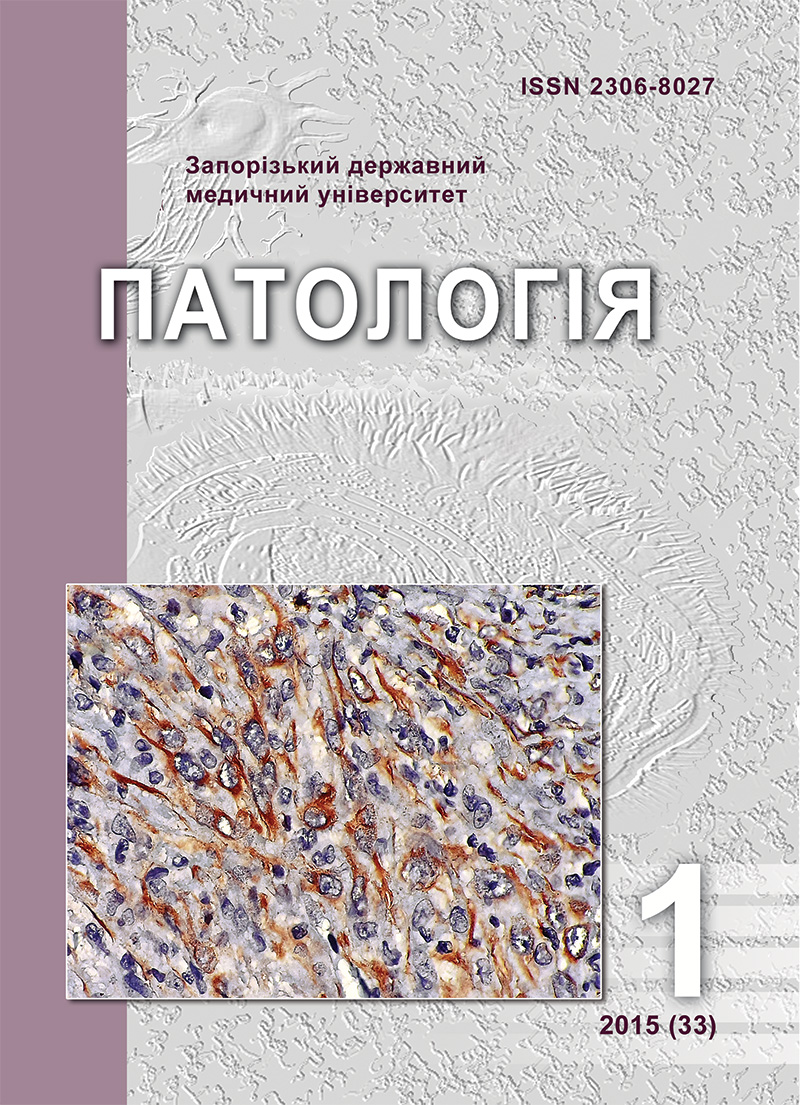Immunohistochemical characteristics of renal cell carcinoma with intravenous extension
DOI:
https://doi.org/10.14739/2310-1237.2015.1.42930Keywords:
Renal Cell Carcinoma, Thrombosis, Matrix Metalloproteinase 9, ImmunohistochemistryAbstract
Up to this day, there is still no sufficient data on immunohistochemical characteristics of intravenous neoplastic thrombi, as well as there is still no general theory about their formation process.
Aim. In order to clarify the pathogenesis of macroscopic intravenous proliferation of renal cell carcinoma, both with and without intravenous invasion, in the group of 94 patients the expression of MMP-9, type IV collagen, a marker of endothelial cells (CD 31) and vascular endothelial growth factor (VEGF) were assessed by immunohistochemical tests.
Methods and results. It was determined, that the expression of MMP-9 and VEGF was significantly higher in the group with macroscopic intravenous tumor proliferation, and it did not correlate either with the extent of thrombus or primary tumor size.
Conclusion. The results are evident of important role of the matrix metalloproteinase-9 and VEGF in the intravenous proliferation of RCC pathogenesis.
References
Hoehn, W. & Hermanek, P (1983) Invasion of veins in renal cell carcinoma – frequence, correlation and prognosis. Eur.Urol, 9, 24–29.
Ljungberg, B., Stenling, R., Osterdahl, B. Farrelly, E., Aberg, T., & Roos, G. (1995) Vein invasion in renal cell carcinoma: impact on metastatic behavior and survival. J. Urol., 154(5), 1681–1684. doi: 10.1016/S0022-5347(01)66749-1.
Pereverzev, A. S. (1997) Khirurgiya opukholej pochki i verkhnikh mochevykh putej [Surgery kidney and upper urinary tract ] Kharkov: Lora Medpharm [in Ukrainian].
Bourboulia, D. & Stetler-Stevenson, W. G. (2010) Matrix metalloproteinases (MMPs) and tissue inhibitors of metalloproteinases (TIMPs): Positive and negative regulators in tumor cell adhesion. Seminars in Cancer Biology, 20, 161–168. doi: 10.1016/j.semcancer.2010.05.002.
Kugler, A., Hemmerlein, B., Thelen, P. Kallerhoff, M., Radzun, H. J., & Ringert, R. H. (1998) Expression of metalloproteinase 2 and 9 and their inhibitors in renal cell carcinoma. J. Urol., 160, 1914–1918.
Anichkov, N. M., Kvetnoj, I. M. & Konovalov, S. S. (2004) Biologiya opukholevogo rosta [Biology of tumor growth]. Saint Petersburg : Praim Yevroznak. [in Russian].
Baryshnikov, A. Yu., Stepanova, E. V. & Lichincer, M. R. (2000) Ocenka angiogeneza opukholej [Assessment of tumor angiogenesis]. Uspekhi sovremennoj biologii, 6, 599–604. [in Russian].
Lucenko, C. V., Kiselev, C. M., Fel`dman, N. B. & Severin, C. E. (2004) Molekulyarnye mekhanizmy angiogeneza v fiziologicheskikh i patologicheskikh processakh [Molecular mechanisms of angiogenesis in physiological and pathological processes]. Vvedenie v molekulyarnuyu medicine. V.A. Pal`cev (Ed.). Moscow: Medicina [in Russian].
Avtandilov, G. G. (2002) Osnoyi kolichestvennoj patologicheskoj anatomii [Fundamentals of quantitative pathological anatomy] Moskow: Medicina [in Russian].
Downloads
How to Cite
Issue
Section
License
Authors who publish with this journal agree to the following terms:- Authors retain copyright and grant the journal right of first publication with the work simultaneously licensed under a Creative Commons Attribution License that allows others to share the work with an acknowledgement of the work's authorship and initial publication in this journal.

- Authors are able to enter into separate, additional contractual arrangements for the non-exclusive distribution of the journal's published version of the work (e.g., post it to an institutional repository or publish it in a book), with an acknowledgement of its initial publication in this journal.
- Authors are permitted and encouraged to post their work online (e.g., in institutional repositories or on their website) prior to and during the submission process, as it can lead to productive exchanges, as well as earlier and greater citation of published work (SeeThe Effect of Open Access).

